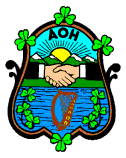Today in Gaelic is
 |
Help support Irish Heritage and Culture and Only requirement to become an Associate Member
of the
Ancient Order of Hibernians, Brothers of St. Patrick |
|
Post Your Web Site Click here to submit your web site that includes Irish and Illinois family roots. This is a free listing to help you and others expand your genealogical search. |
Queries Click here to visit our message board or to post a query. This is a good way to locate relatives in Illinois. We do NOT conduct genealogy searches. Click Here for suggestions on how to start your own family search.yr own search. |
Surnames & Web Sites Henneberry, Henebry, Henebery, Magner, Dunn, Bresnan, Foley, Cussen, Cushing, Coveny, Waddell, Tynan, Hayes, Fruin, Nolan, Kinney, Kiely, Knowles, McGowan, Dalton, Reeves, O'Brien, O'Connell, Hogan, Delahunty and hundreds more. |
|
The Great Potato Famine. From 1843 to 1851 over 1 million Irish starved and over 2 million emigrated to other countries. As a result of "An Gorta Mor" and political/religious persecution, many of the Irish emigrated to the United States in 1847-1855. Some of them settled near Chicago, Illinois and later many moved to central Illinois counties of Macon, Shelby, Moultrie and Christian. |
|
Why Did They Settle in Illinois? The
construction of the Illinois and Michigan Canal brought many Irish to
Illinois. In 1823, the new state of Illinois created a canal
commission. No progress was made until a second commission was
formed in 1835 with a federal grant of 284,000 acres. Most of the
land was offered for sale at $1.25 an acre, but sales were slow and
further problems arrived with the economic "Panic of 1837".
"American History texts" written mostly by the English would
have us believe that the Irish and other immigrants were ignorant,
poorly educated and lazy. More intelligent research indicates the
opposite. The Irish engineering, surveying, political and
financial talents provided the impetus to complete the canal.
Michael Ryan, an engineer and Illinois State Senator, went to London to
negotiate a loan of $1,600,000. This loan made possible the
completion of the canal. |
